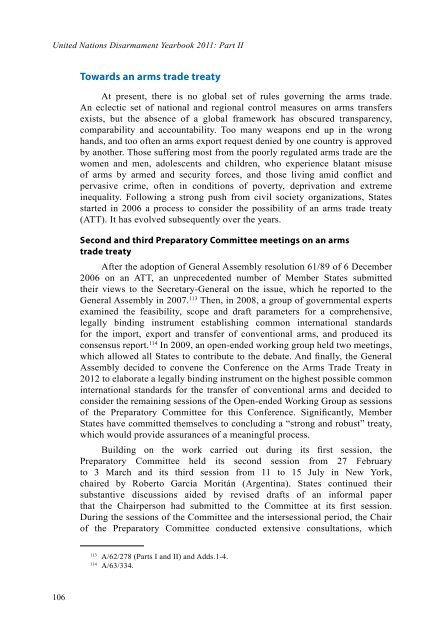DYB2011-Part-II-web
DYB2011-Part-II-web
DYB2011-Part-II-web
You also want an ePaper? Increase the reach of your titles
YUMPU automatically turns print PDFs into web optimized ePapers that Google loves.
United Nations Disarmament Yearbook 2011: <strong>Part</strong> <strong>II</strong><br />
106<br />
Towards an arms trade treaty<br />
At present, there is no global set of rules governing the arms trade.<br />
An eclectic set of national and regional control measures on arms transfers<br />
exists, but the absence of a global framework has obscured transparency,<br />
comparability and accountability. Too many weapons end up in the wrong<br />
hands, and too often an arms export request denied by one country is approved<br />
by another. Those suffering most from the poorly regulated arms trade are the<br />
women and men, adolescents and children, who experience blatant misuse<br />
of arms by armed and security forces, and those living amid conflict and<br />
pervasive crime, often in conditions of poverty, deprivation and extreme<br />
inequality. Following a strong push from civil society organizations, States<br />
started in 2006 a process to consider the possibility of an arms trade treaty<br />
(ATT). It has evolved subsequently over the years.<br />
Second and third Preparatory Committee meetings on an arms<br />
trade treaty<br />
After the adoption of General Assembly resolution 61/89 of 6 December<br />
2006 on an ATT, an unprecedented number of Member States submitted<br />
their views to the Secretary-General on the issue, which he reported to the<br />
General Assembly in 2007. 113 Then, in 2008, a group of governmental experts<br />
examined the feasibility, scope and draft parameters for a comprehensive,<br />
legally binding instrument establishing common international standards<br />
for the import, export and transfer of conventional arms, and produced its<br />
consensus report. 114 In 2009, an open-ended working group held two meetings,<br />
which allowed all States to contribute to the debate. And finally, the General<br />
Assembly decided to convene the Conference on the Arms Trade Treaty in<br />
2012 to elaborate a legally binding instrument on the highest possible common<br />
international standards for the transfer of conventional arms and decided to<br />
consider the remaining sessions of the Open-ended Working Group as sessions<br />
of the Preparatory Committee for this Conference. Significantly, Member<br />
States have committed themselves to concluding a “strong and robust” treaty,<br />
which would provide assurances of a meaningful process.<br />
Building on the work carried out during its first session, the<br />
Preparatory Committee held its second session from 27 February<br />
to 3 March and its third session from 11 to 15 July in New York,<br />
chaired by Roberto García Moritán (Argentina). States continued their<br />
substantive discussions aided by revised drafts of an informal paper<br />
that the Chairperson had submitted to the Committee at its first session.<br />
During the sessions of the Committee and the intersessional period, the Chair<br />
of the Preparatory Committee conducted extensive consultations, which<br />
113 A/62/278 (<strong>Part</strong>s I and <strong>II</strong>) and Adds.1-4.<br />
114 A/63/334.


